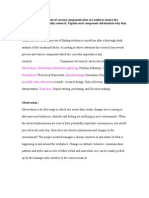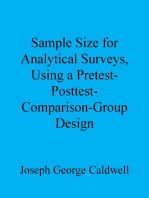50%(2)50% found this document useful (2 votes)
350 viewsData Collection Methods
This document outlines the process for collecting, analyzing, and interpreting data for a research report. It discusses both primary and secondary sources of information. The main methods covered for collecting primary data include interviews, questionnaires, observations, and schedules. It provides details on how to conduct effective interviews, design questionnaires, and structured observations. Common statistical analyses for small-scale studies like calculating frequencies, means, and percentages are also mentioned. The document concludes with discussing how to analyze and interpret the collected data.
Uploaded by
AmanNandaCopyright
© © All Rights Reserved
Available Formats
Download as PPT, PDF, TXT or read online on Scribd
50%(2)50% found this document useful (2 votes)
350 viewsData Collection Methods
This document outlines the process for collecting, analyzing, and interpreting data for a research report. It discusses both primary and secondary sources of information. The main methods covered for collecting primary data include interviews, questionnaires, observations, and schedules. It provides details on how to conduct effective interviews, design questionnaires, and structured observations. Common statistical analyses for small-scale studies like calculating frequencies, means, and percentages are also mentioned. The document concludes with discussing how to analyze and interpret the collected data.
Uploaded by
AmanNandaCopyright
© © All Rights Reserved
Available Formats
Download as PPT, PDF, TXT or read online on Scribd
You are on page 1/ 17
Compilation and interpretation of primary
and secondary sources of information.
The integration of different sources will
consolidate the write up of the report.
DATA COLLECTION
primary Secoud
ry
SOURCES OF INFORMATION
Primary Source
Data is collected by
researcher himself
Data is gathered
through questionnaire,
interviews,
observations etc.
Secondary Source
Data collected,
compiled or
written by other
researchers eg. books,
journals, newspapers
Any reference must
be acknowledged
STEPS TO COLLECT DATA
DATA ANALYSIS AND INTERPRETATION
REVIEW & COMPILE SECONDARY SOURCE INFORMATION
(Referred to in the BACKGROUND/ INTRODUCTION section of report)
PLAN & DESIGN DATA COLLECTION INSTRUMENTS
TO GATHER PRIMARY INFORMATION
(Referred to in the FINDINGS, CONCLUSIONS &
RECOMMENDATIONS sections of report)
DATA COLLECTION
METHODS USED
TO COLLECT
PRIMARY SOURCE DATA
1. Interviews
2. Questionnaires
3. Observation
4. Schedule
5. Other method(warranty cards,distributor audits,pantry audits,
Consumer audits)
However, for a small-scale study, the most commonly used
methods are interviews, survey questionnaires and observations.
Effective way
of gathering
information
INTERVIEW
Involves verbal
and non-verbal
communications
Can be conducted
face to face, by telephone,
online or through mail
Steps To An Effective Interview
Prepare your interview schedule
Select your subjects/ key informants
Conduct the interview
Analyze and interpret data collected from the interview
The most common
data collection instrument
Survey
Questionnaire
Useful to collect
quantitative and qualitative
information
Should contain 3 elements:
1. Introduction to explain the objectives
2. Instructions must be clear, simple language & short
3. User-friendly avoid difficult or ambiguous questions
2 Basic Types of survey
questions:
1. Open-ended Questions
Free-response
(Text Open End)
Fill-in relevant
information
2. Close-ended Questions
Dichotomous question
Multiple-choice
Rank
Scale
Categorical
Numerical
Note: For specific examples and students activities on each question style,
please refer to the notes on Data Collection in the e-learning.
Steps To An Effective Survey Questionnaire
Prepare your survey questions
(Formulate & choose types of questions, order them, write instructions, make copies)
Select your respondents/sampling
Random/Selected
Administer the survey questionnaire
(date, venue, time )
Analyze and interpret data collected
Tabulate data collected
(Statistical analysis-frequency/mean/correlation/% )
A sample of complete survey questionnaire
http://www.custominsight.com/demo/form_widgets.rtf
Observe verbal &
non-verbal communication,
surrounding atmosphere,
culture & situation
Observations
Need to keep
meticulous records of
the observations
Can be done through discussions,
observations of habits, rituals,
review of documentation,
experiments
Steps To An Effective Observation
Determine what needs to be observed
(Plan, prepare checklist, how to record data)
Select your participants
Random/Selected
Conduct the observation
(venue, duration, recording materials, take photographs )
Analyze and interpret data collected
Compile data collected
DIFFERENCE B/W
QUESTIONNAIRES AND SCHEDULES
SCHEDULE QUESTIONNAIRES
.It is generally filled up by
the research worker or the
enumerator
.There are enumerators who
can interpret questions when
necessary
.To collect data through is
relatively more expensive
since consider amt of money
has to be spent in appointing
enumerator and in preparing
schedules
.The questionnaires is
generally sent through mail
.In questionnair the question
are answered without any
assistance from the center
. Collecting data through
questionnair is relatively
cheap and economical
.Non response is generally
low in case of schedule
.There remains the danger of
biasness
.In case of schedule the
identity of respondent is
known
.Risk of collecting incomplete
and wrong inf is less
. Non response is usually
high in case of questionnair
as many people do not return
the questionnair
.Danger of interviewer
biasness and cheating is less
in questional.
.In case of quesna.. It is not
always clear who replies
.Risk of collecting incomplete
and wrong inf is more
Other methods
1. Warranty cards:
Warranty cards are usually postal sized cards which are used by
dealers of consumer durables to collect information regarding
their products. The information sought is printed in the form of
questions on the warranty cards which is placed inside the
package along with the product with a request to the consumer
to fill in the card and post it back to the dealer.
2.Projective techniques
Projection techniques for collection of data have been developed
by psychologists to use projection to use protection of
respondents for inferring abt underline motives ,urge or
intentions which are such that the respondent either resists or to
reveal them or is unable to figure out himself
DATA ANALYSIS
3. In a small scale study, the most common forms of statistical
analysis presented are:
Frequency
Mean
Percentage
1. To analyse data from interviews and observation, use
Summary sheet
Checklist
2. To analyse data from questionnaires, use
Manually
SPSS
DATA INTERPRETATION
1. It involves 2 terms
Results presentation of data/findings (statistics)
Discussion interpretation of data/findings
2. Things to consider when interpreting your data:
Interpret findings based on the purpose and
objectives of your study
Relate the findings to real life context
Use persuasive language to convince your readers
to see the research from your point of view.
Order your interpretation to highlight the most important
findings
Include limitations to your research.
Use simple, clear language
You might also like
- HMEF5093 Quantitative Research MethodologyNo ratings yetHMEF5093 Quantitative Research Methodology211 pages
- CJUS500 - Article Critique Assignment InstructionsNo ratings yetCJUS500 - Article Critique Assignment Instructions2 pages
- Piercy - Analysis of Semi-Structured Interview DataNo ratings yetPiercy - Analysis of Semi-Structured Interview Data16 pages
- The Success of Atty. Erwin Erfe, M.D. in Medicine and Law PDFNo ratings yetThe Success of Atty. Erwin Erfe, M.D. in Medicine and Law PDF30 pages
- An Introduction To Qualitative ResearchNo ratings yetAn Introduction To Qualitative Research35 pages
- Prospectus Discussion Notes 33 Ppgs Upload100% (1)Prospectus Discussion Notes 33 Ppgs Upload33 pages
- Data Collection Is An Important Aspect of Any Type of Research StudyNo ratings yetData Collection Is An Important Aspect of Any Type of Research Study20 pages
- How Theories Are Developed-Converted Lecturer 04No ratings yetHow Theories Are Developed-Converted Lecturer 0419 pages
- Quantitative & Qualitative Research: Adesas, Kristel Mae M. & Arce, Jeoffrey J100% (1)Quantitative & Qualitative Research: Adesas, Kristel Mae M. & Arce, Jeoffrey J30 pages
- Data Collection Through Experimentation and SimulationNo ratings yetData Collection Through Experimentation and Simulation22 pages
- Presentation On Methods of Data CollectionNo ratings yetPresentation On Methods of Data Collection57 pages
- Primary and Secondary Sources of Data Collection67% (3)Primary and Secondary Sources of Data Collection15 pages
- Secondary Data Research in A Digital AgeNo ratings yetSecondary Data Research in A Digital Age30 pages
- Participant Observation: History and DevelopmentNo ratings yetParticipant Observation: History and Development6 pages
- Fowler (1995) - Improving Survey Questions. Design and Evaluation.No ratings yetFowler (1995) - Improving Survey Questions. Design and Evaluation.4 pages
- Organizational Research Methods: (Pick The Date)No ratings yetOrganizational Research Methods: (Pick The Date)15 pages
- Difference Between Correlation and Regression in StatisticsNo ratings yetDifference Between Correlation and Regression in Statistics1 page
- Framing Your Research Question: Dr. Sharif Abbasi100% (1)Framing Your Research Question: Dr. Sharif Abbasi21 pages
- HANDOUT #1 - Introduction To Business ResearchNo ratings yetHANDOUT #1 - Introduction To Business Research30 pages
- Social Research Methods Class IV: Dr. Shubhasree Bhadra University of Calcutta May 6, 2021100% (2)Social Research Methods Class IV: Dr. Shubhasree Bhadra University of Calcutta May 6, 202122 pages
- Adherence To The Three Criteria Mentioned Above Enables The Process To Be Called Research'No ratings yetAdherence To The Three Criteria Mentioned Above Enables The Process To Be Called Research'9 pages
- Section - V Interpretation Report WritngNo ratings yetSection - V Interpretation Report Writng46 pages
- Sample Size for Analytical Surveys, Using a Pretest-Posttest-Comparison-Group DesignFrom EverandSample Size for Analytical Surveys, Using a Pretest-Posttest-Comparison-Group DesignNo ratings yet
- Name S. No. Gender (M / F) Age (In Years) CGPA Till NowNo ratings yetName S. No. Gender (M / F) Age (In Years) CGPA Till Now9 pages
- Impact of E-Commerce On Business ActivityNo ratings yetImpact of E-Commerce On Business Activity36 pages
- The Group & Interpersonal Behavior: By:-Deepanshu Rohit Vikash PrakeshNo ratings yetThe Group & Interpersonal Behavior: By:-Deepanshu Rohit Vikash Prakesh21 pages
- Method of Data Collection: Aishwarya Vidyasagar Akashdeep Singh Utkarsh Amaravat Apurvi Patel Bhavesh BarasaraNo ratings yetMethod of Data Collection: Aishwarya Vidyasagar Akashdeep Singh Utkarsh Amaravat Apurvi Patel Bhavesh Barasara16 pages
- Employee Satisfaction in Bharti Airtel Limited (B (It)100% (4)Employee Satisfaction in Bharti Airtel Limited (B (It)73 pages
- Daily Orientation Report: Learning OutcomesNo ratings yetDaily Orientation Report: Learning Outcomes1 page
- Learning From Others and Reviewing The Literature (Cont.) : by Group 4No ratings yetLearning From Others and Reviewing The Literature (Cont.) : by Group 411 pages
- [PSU Admissions] PSUCAT 2025 Test PermitNo ratings yet[PSU Admissions] PSUCAT 2025 Test Permit2 pages
- Rhythm and Reading Development in School-Age Children A Longitudinal Study PDFNo ratings yetRhythm and Reading Development in School-Age Children A Longitudinal Study PDF285 pages
- Motivation On The Adversity Quotient and Self Reliance50% (2)Motivation On The Adversity Quotient and Self Reliance10 pages
- B1 Preliminary For Schools - Plan (13 Sep 2021) : WritingNo ratings yetB1 Preliminary For Schools - Plan (13 Sep 2021) : Writing2 pages
- Internal Assessment HL - Sample C Examiner CommentsNo ratings yetInternal Assessment HL - Sample C Examiner Comments3 pages
- Notice OF Examination: Promotion To Supervisor Ii (Social Services) Exam No. 2522No ratings yetNotice OF Examination: Promotion To Supervisor Ii (Social Services) Exam No. 25223 pages
- CJUS500 - Article Critique Assignment InstructionsCJUS500 - Article Critique Assignment Instructions
- Piercy - Analysis of Semi-Structured Interview DataPiercy - Analysis of Semi-Structured Interview Data
- The Success of Atty. Erwin Erfe, M.D. in Medicine and Law PDFThe Success of Atty. Erwin Erfe, M.D. in Medicine and Law PDF
- Data Collection Is An Important Aspect of Any Type of Research StudyData Collection Is An Important Aspect of Any Type of Research Study
- Quantitative & Qualitative Research: Adesas, Kristel Mae M. & Arce, Jeoffrey JQuantitative & Qualitative Research: Adesas, Kristel Mae M. & Arce, Jeoffrey J
- Data Collection Through Experimentation and SimulationData Collection Through Experimentation and Simulation
- Fowler (1995) - Improving Survey Questions. Design and Evaluation.Fowler (1995) - Improving Survey Questions. Design and Evaluation.
- Difference Between Correlation and Regression in StatisticsDifference Between Correlation and Regression in Statistics
- Social Research Methods Class IV: Dr. Shubhasree Bhadra University of Calcutta May 6, 2021Social Research Methods Class IV: Dr. Shubhasree Bhadra University of Calcutta May 6, 2021
- Adherence To The Three Criteria Mentioned Above Enables The Process To Be Called Research'Adherence To The Three Criteria Mentioned Above Enables The Process To Be Called Research'
- Sample Size for Analytical Surveys, Using a Pretest-Posttest-Comparison-Group DesignFrom EverandSample Size for Analytical Surveys, Using a Pretest-Posttest-Comparison-Group Design
- Name S. No. Gender (M / F) Age (In Years) CGPA Till NowName S. No. Gender (M / F) Age (In Years) CGPA Till Now
- The Group & Interpersonal Behavior: By:-Deepanshu Rohit Vikash PrakeshThe Group & Interpersonal Behavior: By:-Deepanshu Rohit Vikash Prakesh
- Method of Data Collection: Aishwarya Vidyasagar Akashdeep Singh Utkarsh Amaravat Apurvi Patel Bhavesh BarasaraMethod of Data Collection: Aishwarya Vidyasagar Akashdeep Singh Utkarsh Amaravat Apurvi Patel Bhavesh Barasara
- Employee Satisfaction in Bharti Airtel Limited (B (It)Employee Satisfaction in Bharti Airtel Limited (B (It)
- Learning From Others and Reviewing The Literature (Cont.) : by Group 4Learning From Others and Reviewing The Literature (Cont.) : by Group 4
- Rhythm and Reading Development in School-Age Children A Longitudinal Study PDFRhythm and Reading Development in School-Age Children A Longitudinal Study PDF
- Motivation On The Adversity Quotient and Self RelianceMotivation On The Adversity Quotient and Self Reliance
- B1 Preliminary For Schools - Plan (13 Sep 2021) : WritingB1 Preliminary For Schools - Plan (13 Sep 2021) : Writing
- Internal Assessment HL - Sample C Examiner CommentsInternal Assessment HL - Sample C Examiner Comments
- Notice OF Examination: Promotion To Supervisor Ii (Social Services) Exam No. 2522Notice OF Examination: Promotion To Supervisor Ii (Social Services) Exam No. 2522











































































































